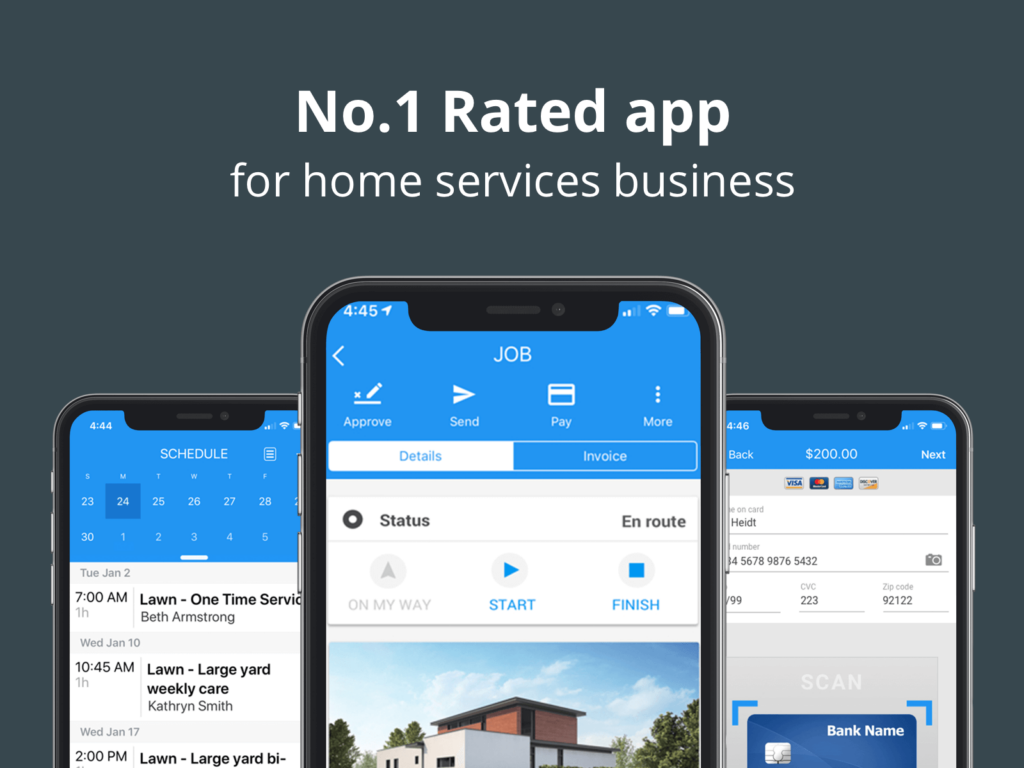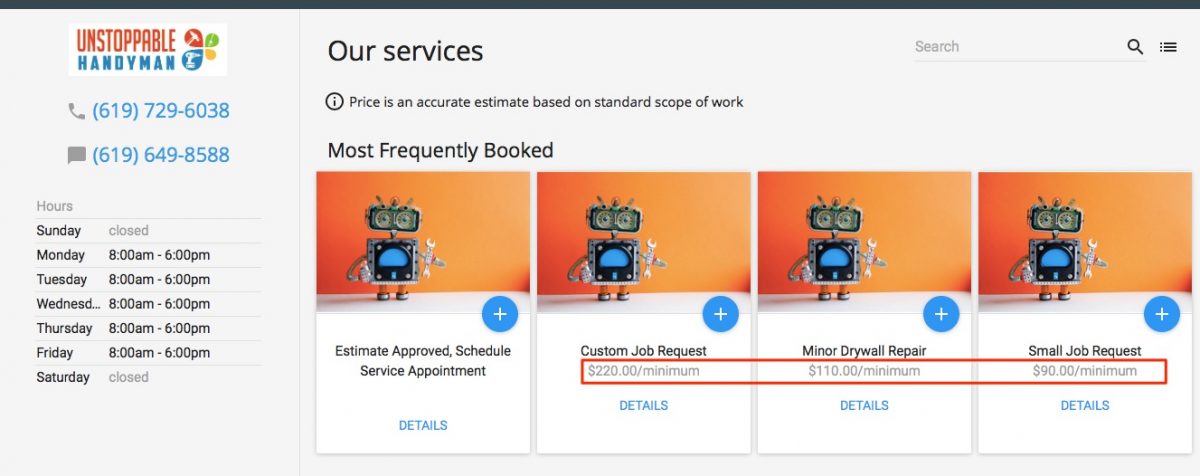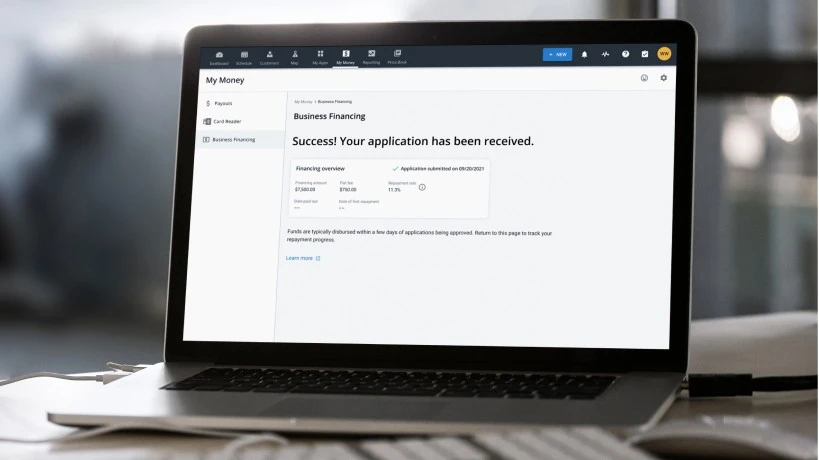
Do you like to fix things? Were you one of those kids who loved separating things just to see how they worked? Do you love seeing something broken and figuring out how to make it work again? Do you love building new things? If you answered yes to any of these questions and you have an entrepreneurial spirit, then starting a handyman business might be a great opportunity for you.
The truth is that only some can fix things. And even some who do often don’t have the time to tinker. So, they turn to those with the skills and tools to do the work right the first time. This is where handyman businesses can come in handy—pun intended. Handypersons can build, fix, and get things done that others don’t have the time, patience, talent, or interest to do themselves.
Does starting a handyman business sound interesting to you? To help you out on your journey, we’ve created this guide which is filled with curated advice from successful business owners and industry experts about the ins and outs of the market.
How to Start Your Own Handyman Business: Step by Step
- 1. Draft Your Handyman Business Plan
- 2. Determine Your Services
- 3. Research Legal Requirements
- 4. Register Your New Business
- 5. Get Business Insurance
- 6. Set Up Finances
- 7. Determine Your Handyman Pricing Strategy
- 8. Purchase the Right Tools and Equipment
- 9. Invest in Marketing to Land Your First Client
- 9. Go Beyond Client Expectations with Exceptional Customer Service
- 10. Streamline Operations with Handyman Business Software
- Next Steps in Starting Your Own Handyman Business
Starting a handyperson business can be quite a lucrative business venture. In fact, the handyman industry is on the rise, with the U.S. market valued at $390.9 million in 2023 and projected to hit $1.8 billion by 2033. On a global scale, handyman services reached a market value of $342 million in 2022. Those are some pretty big numbers. If you have the skills or interest, you can claim part of that market share.
But how do you get started? We’ve got the insights you need on how to start your own handyman business.
1. Draft Your Handyman Business Plan

Many people who go into the handyperson industry start small. Perhaps they sign up to promote their services on sites like Angi or Thumbtack. This helps them get some jobs under their belt and insight into what services they enjoy and have the talent for, and what doesn’t give them that same energy.
But this isn’t to say you have to start small and just go into things on a part-time basis. If you are truly invested in making this your business, then by all means, go for it. And it all starts with creating your business plan.
Business Plan Essentials
Creating a business plan is the foundation of a successful handyman company. This document helps you define your goals and map out the steps you’ll take to reach them, providing a solid blueprint for the future. When crafting your business plan, start with an overview of your business vision and the types of handyman services you intend to offer (we’ll talk about that a bit more shortly). Next, focus on budgeting for startup costs, which may include tools, licenses, insurance, and other essentials needed to get your business running.
Outline a sales strategy that details how you will attract and retain clients, whether through online platforms, word of mouth, or local advertising. If you need financing, include a funding section to specify how much you’ll need and potential sources of funding. Additionally, create a marketing plan to promote your services, and estimate your ongoing expenses, such as material costs, travel, and advertising. Finally, include revenue projections to give you a realistic view of how much you aim to make over time.
Additional Resources To Help You Get Started
- Handyman Business Plan Template – Avoid costly mistakes and get a clear roadmap outlining business goals, startup costs, pricing, and profit margins for better budgeting.
- Handyman Business Checklist – Prioritize and complete necessary steps, such as licensing, insurance, marketing, and tool acquisition, ensuring nothing crucial is overlooked.
How Much Does it Cost to Start a Handyman Business?
One of the important things to understand before going into any business is knowing the start-up costs. For a handyperson in particular, you’re likely going to need more than a hammer and a tool belt. You’ll need to plan for quite a few tools plus more business-focused expenses such as licensing, insurance, and of course, marketing and advertising.
With all this said, you can get started with an initial investment between $2,000 and $6,000, not including the cost of a vehicle to get you from job to job.
Bootstrapping Versus External Funding
Jeremy Winnie started JW Handyman Services and Home Renovations with little savings and only a set of hand tools. He didn’t take out any loans or look for other external funding. Instead, Jeremy built up his company as he went, buying new equipment with the revenue he made from past jobs.
This is the bootstrapping method — using one’s existing resources instead of asking for outside funding.
When Jeremy got started, his wife Katie was working as a vet technician full-time. After eight months, Katie quit her job and began working full-time for the handyman business, handling administrative tasks such as answering the phone scheduling jobs, and managing the books.
Two years later, the business has a team of six, is booked three months out, and has increased its annual revenue by 1395%.
While they’re now finding success, according to Katie, if they had to do it all over again, they would have taken out a small business loan to hit the ground running. “What we did is really hard to accomplish,” she explained.
2. Determine Your Services

As you work through that business plan, you will need to decide the types of services you want to offer. And this can really run the gamut, but you mustn’t take on more than you can truly offer. If you aren’t great at a particular service, don’t offer it unless you have another resource who can manage that type of work.
In most cases, you’ll want to offer services such as:
- General repairs: Tackle common household fixes, including minor repairs on doors, windows, and furniture.
- Carpentry: Provide services like building shelves, installing cabinets, and other woodworking tasks.
- Plumbing: Handle minor plumbing jobs, such as fixing leaks, replacing faucets, and unclogging drains.
- Electrical work: Offer basic electrical services, like replacing light fixtures, installing outlets, and repairing switches.
- Painting: Perform indoor and outdoor painting, touch-ups, and wall preparation for a fresh, clean look.
You may also want to consider some more specialized services that homeowners and business owners look for. Consider things like drywall repair, wallpaper installation and removal, or seasonal maintenance. The goal is to consider where your talents lie and what customers in your area need.
3. Research Legal Requirements
Make sure that you have all of the appropriate legal requirements and certifications in place before you start taking on jobs. Most states have requirements for this type of work, and failure to comply can result in some pretty hefty fines.
Do I Need a License to Start a Handyman Business?
To run your own business, you’ll need to register your business on the federal, state, and local levels, including registering for a tax ID. You’ll need this ID to open a business banking account and get insured. If you’re not sure how to register, you can work with a registered agent. Be sure to look into the laws and licensing requirements in your city and state. Here is what you will need to consider:
- Business licenses: Many cities and states require a general business license to operate legally. Check local regulations to see if you need to register as a business entity or sole proprietor.
- Contractor licenses: Some handyman services, like electrical or plumbing work, may require a specialized contractor license.
- Permits for specific services: Certain types of work, such as large-scale repairs, electrical upgrades, or structural modifications, often require permits.
Additional Resources
- Check out our guide to handyman licenses by state.
4. Register Your New Business
To be considered an official business rather than just a side hustle, you will need to register your business. There are different business structures to consider before you take this step. We suggest talking to an accountant or fiduciary about the different types of business structures. Here are the typical options:
Sole Proprietorship
A sole proprietorship is the simplest structure, where the business owner and the business are legally the same entity. While it’s easy to set up and manage, the owner is personally liable for business debts and obligations. Taxes are filed through the owner’s personal tax return, simplifying reporting but increasing personal risk.
Limited Liability Company (LLC)
An LLC—a limited liability company—provides a separation between the business and personal assets, offering protection from personal liability for business debts. LLCs can be managed by members (owners) or designated managers, and they offer flexible tax options, allowing owners to choose between personal tax filings or corporate tax structures.
Corporation
A corporation is a more complex structure with shareholders and a board of directors, which separates personal assets from business liabilities. It often has higher setup and management costs, but it can offer tax benefits, especially for larger businesses. Corporations pay taxes separately from personal income, though smaller corporations may choose “S Corp” status to avoid double taxation.
To officially register your business, follow these steps:
- Start by selecting a memorable and professional business name that reflects your services.
- Obtain a federal Employer Identification Number (EIN) from the IRS for tax purposes.
- Complete the necessary state and local registrations, which may vary by location but are required to operate legally in your area.
5. Get Business Insurance

Most states require that those going into the handyman business purchase business insurance. And, this is for good reason. Because your work will often occur at the client’s site, you open yourself up to several vulnerabilities and will want to make efforts to protect yourself if something goes wrong. Insurance can help protect you in the event of property damage, injury, or a legal dispute.
In most cases, handypersons will invest in the following types of insurance.
- General Liability Insurance: Protects against claims of property damage, bodily injury, or personal injury to clients or third parties. This insurance is key for covering unexpected accidents that could occur while you’re working on a client’s property.
- Workers’ Compensation: If you have employees, this insurance helps cover medical expenses and lost wages if they’re injured on the job. It’s also often required by law if you have one or more employees.
- Commercial Auto Insurance: Covers vehicles used for business purposes, protecting against accidents, property damage, and liability. This policy is important if you rely on a truck or van to transport tools and supplies to job sites.
When choosing the right insurance policy, comparing options and understanding each policy’s terms is a must. Here are some tips to guide you:
- Compare quotes from multiple providers: Get estimates from various insurers to find a policy that suits your budget without sacrificing necessary coverage.
- Understand coverage limits and exclusions: Review the limits on your policy to know the maximum payout, and make sure you understand what situations or types of claims may not be covered.
- Ask about industry-specific coverage options: Some policies are tailored for handyman businesses, so ask providers if they offer plans that address the specific risks associated with your work.
6. Set Up Finances

Once you have established your business structure and have obtained your EIN, it’s time to set up your finances. And this is something we recommend that you talk to your accountant about before getting too far, as they may have suggestions on the types of accounts you set up.
That said, keeping your personal and business finances separate is going to be super important for you going forward. Once you are set-up, link your accounts to QuickBooks to make things even easier.
7. Determine Your Handyman Pricing Strategy
Your pricing strategy will be a vital component of your business success. Pricing your services too high may put you out of the game before you even get started. Also, pricing your services too low might certainly get you more business, but it can quickly turn into cash flow problems. Since about 82% of small businesses in the U.S. fail due to cash flow issues, do your due diligence so you don’t become part of the statistics.
Here are some tips to help you come up with the right pricing and job-costing strategy for your handyman business.
Research Local Market Rates
Start by researching what other handypersons in your area are charging. Look at similar businesses and consider the range of rates offered. This will help you set competitive pricing while remaining profitable. You can gather this information by exploring local service websites, asking for quotes as a potential customer, and checking online marketplaces for handyman services.
Conduct Competitor Analysis
Take a closer look at your competitors to understand what they include in their pricing, such as warranties, customer support, or specialized services. This insight will allow you to differentiate your services and determine what aspects might justify a slightly higher rate, if applicable.
Choose a Pricing Strategy
- Flat Rates: Charge a set price for specific tasks, which can help customers understand their costs upfront.
- Hourly Rates: Bill clients by the hour for jobs that may vary in length, allowing flexibility based on project complexity.
- Value-Based Rates: Set prices based on the value you provide, such as offering specialized skills or exceptional customer service, rather than just the time it takes to complete the job.
Additional Resources:
Business owners are cautious about customers signing up for jobs that aren’t a good fit for them. List the types of jobs you feel most comfortable booking online. For instance, Blessed Hands Handyman has a detailed breakdown of many of their most common services for customers to choose from.

Consider setting a minimum price per job as Unstoppable Handyman does. In the different service details, they explain that the minimum cost covers a certain time amount and what additional time will cost.
Calculating Your Costs
To set profitable pricing, you need to calculate all relevant costs. Use this formula:
Total Cost = Labor + Materials + Overhead + Desired Profit Margin
Estimate labor costs based on the time required to complete a job, and include the cost of any materials used. Don’t forget to account for overhead expenses, such as vehicle maintenance, tools, insurance, and advertising. Then, decide on a profit margin that allows you to grow your business over time.
8. Purchase the Right Tools and Equipment

As we said earlier, you’re going to need more than a hammer and a tool bet to get started in the handyman business. And remember how we mentioned that you’d need about $2,000 to $6,000 to get started? Well, a lot of that expense is going to be right here as you purchase the right tools and equipment to do the job, with the balance of those funds going to insurance and marketing expenses.
Here’s what you’ll likely need to get set up.
- Work Vehicle: A reliable truck or van to transport tools, equipment, and materials safely to and from job sites.
- Basic Hand Tools: Essential items like hammers, screwdrivers, tape measures, wrenches, pliers, utility knives, and a level. These tools are the foundation of most handyman tasks.
- Power Tools: Key equipment such as a drill, impact driver, circular saw, reciprocating saw, and electric sander. Power tools help you complete tasks efficiently and are valuable for various projects.
- Safety Gear: Protective items include gloves, safety glasses, ear protection, a hard hat, and knee pads. Safety gear helps reduce the risk of injury while working.
- Specialty Tools: Additional tools based on specific services you’ll offer, such as a stud finder, plumbing wrenches, wire cutters, and socket sets. Specialty tools allow you to handle a broader range of repairs and installations.
Additional Resources: Get the right tools for your new handyman venture by grabbing a copy of our Handyman Tools List Checklist.
Get In Touch: 858-842-5746
Let us earn your trust
On average, Pros increase monthly revenue generated through Housecall Pro by 50% after their first year.
See plan options and feature breakdown on our pricing page.
9. Invest in Marketing to Land Your First Client
Marketing and advertising are where it’s at to help you land your clients. And we’re going to offer you some tips and suggestions to help you get started. But before we do, let’s talk a bit about word-of-mouth advertising and how to get some of those first clients who can help spread the positive buzz.
One tried-and-true approach is to reach out to family and friends with a special one-time introductory offer. This can be a smaller, low-cost project that you can do to help you “get in the zone” and to help you get some positive reviews for your social media channels. Think of this like a soft launch before your grand opening.
That said, you’re going to need to make marketing a big part of your business strategy. And most small businesses spend between 7% to 9% of their revenue on marketing and advertising-related expenses.
Before you get too far, start with the following:
- Create a Logo: Design a simple, memorable handyman logo that reflects your business and the types of services you offer.
- Develop a Tagline: Craft a brief and catchy tagline that highlights what makes your services valuable.
- Choose Brand Colors and Fonts: Pick consistent colors and fonts across your materials, from your website to business cards.
- Establish a Tone and Style for Marketing: Decide on the tone (friendly, professional, straightforward) you’ll use in your communications.
- Design Business Cards and Flyers: Physical marketing materials like brochures can help spread the word locally and give potential clients something tangible to remember you by.
Creating Your Handyman Marketing Strategy
With those initial branding exercises complete, it’s time to create your marketing presence. And being online is the place to be. Here’s what you need to do.
- Create a Professional Website: Build a simple, user-friendly website that provides an easy-to-understand list of your services, contact information, pricing, and client testimonials. A website gives potential clients a place to learn more about your business.
- Set Up a Google Business Profile: Register your business on Google to appear in local search results. This can boost visibility when people in your area search for handyman services, making it easier for clients to find and contact you.
- Leverage Social Media: Use platforms like Facebook, Instagram, and LinkedIn to share project photos, customer reviews, and updates. Social media is a great way to engage with local clients and build credibility.
- Network with Local Hardware Stores: Partner with hardware stores and let them know about your services. They may refer customers needing assistance with repairs or installations.
- Connect with Real Estate Agents and Property Managers: Establish relationships with agents and property managers who often require handyman services for property maintenance and may refer clients to you.
9. Go Beyond Client Expectations with Exceptional Customer Service

As your business starts to grow, it can be so easy to focus on more, more, more. But this can be dangerous territory. If you take on too much, the customer experience can start to wither away, and that’s not going to be good for your reputation or the future of your business.
Delivering above-and-beyond service is key to creating a loyal customer base that will recommend your business and keep coming back. Small but meaningful efforts, like arriving on time, being prepared, and paying close attention to the details of each job, can make a lasting impression. Maintaining a polite and professional demeanor is also important, as it reflects positively on your business and builds trust with clients.
To strengthen your reputation, encourage satisfied clients to leave positive reviews and testimonials on your website and social media. Feature these reviews prominently—they help prospective clients see your dedication to quality service.
Additional Resources:
- Instead of creating invoices from scratch, grab a copy of our Handyman Invoice Template to send to customers after a job well done. Simply fill in the details and customize them to your business.
- Grab our Handyman Service Agreement Template to help clarify the scope of work, payment terms, and other important details, protecting your business from potential disputes with clients.
10. Streamline Operations with Handyman Business Software

Last but not least, we can’t emphasize enough the value of using handyman business software to help your business be the best it can be. While many small business owners, especially in the trade industry, tend to lean on more manual processes, using ink and paper can cost you more in the long run. And, it can cause hiccups when tax time rolls around.
Here are just some of the things that the best handyman software can help with.
- Estimates: Quickly generate accurate estimates for clients, helping you win jobs and maintain transparency on costs.
- Scheduling: Simplify job scheduling and manage your calendar to stay organized and avoid double-booking.
- Invoicing & Payments: Easily create and send invoices, and track payments for faster and more reliable cash flow.
- Customer Relationship Management (CRM): Keep track of client details, job history, and communications to build and maintain strong customer relationships.
- Photo Attachments: Attach photos to job records to document work progress or issues, providing a visual reference for clients and records.
- Checklists: Use customizable checklists to make sure all tasks are completed on each job, helping maintain high service quality.
- Time Tracking: Accurately log hours spent on each job to improve billing accuracy and project timelines.
- Mobile App: Access all these tools on the go with Housecall Pros’ mobile app, allowing you to manage your business from the job site or wherever you are.
Next Steps in Starting Your Own Handyman Business
Are you ready to start your own handyman business? If so, follow the tips in this article to make the set-up process as easy as possible. And, don’t forget to check out our free 14-day handyman business software trial. With our software, your back office will practically run on auto-pilot. Get started today.
Handyman Business FAQs
- What do most handymen charge per hour?
-
The average hourly rate for handymen varies based on location, experience, and the complexity of the job. In the U.S., most handymen typically charge between $50 to $100 per hour. Urban areas or regions with a higher cost of living may see rates on the higher end of the spectrum, while rural or less populated areas might be on the lower end. Additionally, more specialized or skilled services, such as plumbing or electrical work, can command higher rates.
- What is the most a handyman can make a year?
-
On average, a full-time handyman can earn anywhere from $40,000 to $75,000 per year. However, those who have built a strong reputation, expanded their range of services, or run their own handyman business with employees can earn significantly more. Top-earning handymen who run established businesses or focus on high-demand, specialized services can potentially make over $100,000 per year, especially in busy metropolitan areas or regions with high property maintenance needs.







